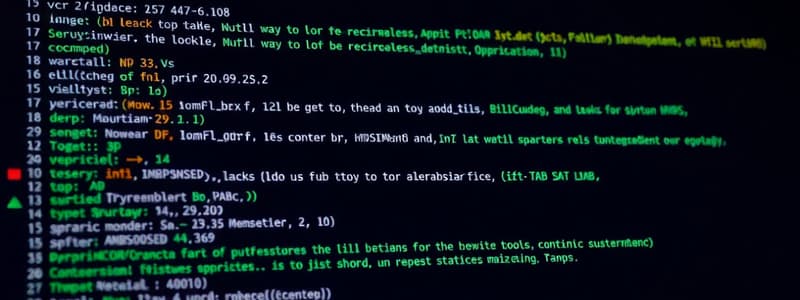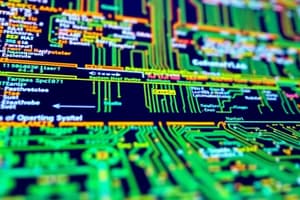Podcast
Questions and Answers
Which function of an operating system directly involves the management of hardware resources?
Which function of an operating system directly involves the management of hardware resources?
- Coordination of application software
- User interaction facilitation
- Hardware management (correct)
- Task scheduling
What type of operating system allows multiple users to access the system simultaneously?
What type of operating system allows multiple users to access the system simultaneously?
- Single-user system
- Batch processing system
- Distributed operating system
- Multi-user system (correct)
Which of the following is not a characteristic of a modern operating system?
Which of the following is not a characteristic of a modern operating system?
- Dependency on a single application for functions (correct)
- Direct interaction with hardware components
- Coordination of tasks between applications
- Ability to manage memory efficiently
How does an operating system enable interaction between the user and the computer?
How does an operating system enable interaction between the user and the computer?
Which statement is true regarding the functionality of utility programs in an operating system?
Which statement is true regarding the functionality of utility programs in an operating system?
What is the primary role of the operating system during the boot process?
What is the primary role of the operating system during the boot process?
Which type of operating system is specifically designed to handle tasks requiring immediate responses to input?
Which type of operating system is specifically designed to handle tasks requiring immediate responses to input?
Which feature is commonly associated with the interface of operating systems like Windows?
Which feature is commonly associated with the interface of operating systems like Windows?
Which operating system is primarily known for its open-source nature?
Which operating system is primarily known for its open-source nature?
What is the primary function of a real-time operating system (RTOS)?
What is the primary function of a real-time operating system (RTOS)?
Which type of user interface primarily features text commands for input?
Which type of user interface primarily features text commands for input?
What term describes the technique of using hard drive space to supplement RAM capacity?
What term describes the technique of using hard drive space to supplement RAM capacity?
Which operating system is specifically designed to allow multiple users simultaneous access?
Which operating system is specifically designed to allow multiple users simultaneous access?
What is the role of a device driver in an operating system?
What is the role of a device driver in an operating system?
Which feature of an operating system enables effective memory management?
Which feature of an operating system enables effective memory management?
Which web-based operating system is primarily used for cloud computing?
Which web-based operating system is primarily used for cloud computing?
What is the structure that organizes the computer's contents called?
What is the structure that organizes the computer's contents called?
Which symbol is used for a file path in Linux?
Which symbol is used for a file path in Linux?
What is the main utility for managing files on a Windows system?
What is the main utility for managing files on a Windows system?
Which of the following actions is NOT typically associated with file management?
Which of the following actions is NOT typically associated with file management?
What term describes the combination of a file name and its type indication?
What term describes the combination of a file name and its type indication?
What is the primary purpose of a file compression utility?
What is the primary purpose of a file compression utility?
Which of the following correctly identifies a characteristic of a file?
Which of the following correctly identifies a characteristic of a file?
In the context of file organization, which option describes subfolders?
In the context of file organization, which option describes subfolders?
What is the primary function of the Application Programming Interface (API)?
What is the primary function of the Application Programming Interface (API)?
What is the correct order of the steps in the boot process?
What is the correct order of the steps in the boot process?
Which role of the BIOS is specifically highlighted in the boot process?
Which role of the BIOS is specifically highlighted in the boot process?
During the boot process, what does the Power-On Self-Test (POST) accomplish?
During the boot process, what does the Power-On Self-Test (POST) accomplish?
What feature allows users to customize their experience on Windows 10 by choosing specific applications to display?
What feature allows users to customize their experience on Windows 10 by choosing specific applications to display?
Which component of the OS is loader into RAM after the system files during the boot process?
Which component of the OS is loader into RAM after the system files during the boot process?
Which of the following statements is accurate regarding the operating systems macOS and Windows?
Which of the following statements is accurate regarding the operating systems macOS and Windows?
What feature of Windows 10 enables users to organize multiple applications into different displays?
What feature of Windows 10 enables users to organize multiple applications into different displays?
Flashcards are hidden until you start studying
Study Notes
Operating System Fundamentals
- The operating system (OS) is responsible for the computer’s hardware management.
- The OS makes it possible for application software to work with the central processing unit (CPU).
- The OS can also manage, schedule, and coordinate various computer tasks.
Understanding System Software
- The top three operating systems for personal computers are Windows, macOS, and Linux.
- Mobile operating systems include Android, iOS, and Windows.
- The OS category can be single or multi-user, in addition to being single or multi-task.
Operating Systems for Machinery, Networks, and Business
- A real-time operating system (RTOS) is used for machines performing repetitive tasks at specific time intervals.
- A multi-user operating system, also known as a network OS, allows multiple users to access the computer simultaneously.
- Unix is an example of such an operating system.
What the Operating System Does
- The operating system provides the user interface which allows for interaction with the computer.
- There are three types of interfaces: command-driven, menu-driven, and graphical user interface (GUI).
- An interrupt handler triggers an event in the computer system.
- The OS uses preemptive multitasking to juggle multiple programs at once.
- A spooler temporarily holds output until the device becomes available.
Hardware Coordination
- The OS manages both memory (RAM) and storage.
- Virtual memory uses space on the drive to extend RAM capabilities.
- Increasing the amount of RAM reduces reliance on virtual memory.
- A swap file stores data being swapped between RAM and the hard drive.
- Paging is the process of moving data between RAM and storage in page-sized chunks.
- Thrashing is excessive swapping between RAM and storage, leading to system slowdown.
- Device drivers allow the OS to communicate with hardware, including peripherals.
- Plug and Play (PnP) automatically configures new hardware components.
- Rollback allows for reverting to a previous state of a device driver.
Software Application Coordination
- The operating system utilizes an application programming interface (API) to communicate with application software.
- The API consists of blocks of code that the CPU recognizes and employs for similar procedures.
- An example of an API is Microsoft Direct X for gaming applications.
Starting Your Computer
- The boot process consists of four steps: powering on, performing the Power-On Self-Test (POST), loading the bootloader, and loading the operating system.
- The Basic Input/Output System (BIOS) handles data exchange between the OS and input/output devices.
- The BIOS loads the OS into RAM.
- The POST ensures essential peripheral devices are connected and functioning correctly.
- The OS system files are loaded into RAM.
- The kernel, the core of the OS, is then loaded.
- The registry stores configurations used by the OS and applications.
The Windows Interface
- The Windows desktop serves as the primary workspace.
- The taskbar displays open and favorite applications.
- The Start menu provides access to all installed applications and apps.
- Pinning allows for selecting specific applications to appear as tiles in the Start menu.
- Virtual desktops enable users to organize groups of windows into different displays.
User Interfaces for Other OSs
- macOS and Windows interfaces are not compatible but offer similar functionalities.
- Linux interfaces are often based on familiar Windows and macOS designs.
File Management
- The file system utilizes a hierarchical structure to organize computer contents.
- This structure includes drives, libraries, folders, subfolders, and files..
- The root directory (C:) represents the top of the filing structure.
- A file is a program instruction or data treated as a single unit stored on a permanent storage device.
- A folder is a collection of files.
- A file path is a sequence of directories that lead to a specific file.
- Windows uses a backslash (), Linux uses a forward slash (/), and macOS uses a colon (:).
- File Explorer is the primary tool for finding, viewing, and managing computer contents.
- It displays the location and contents of every drive, folder, and file.
- File names contain the actual name and an extension that indicates the file type.
- File management includes actions such as opening, copying, cutting, renaming, deleting, and using the Recycle Bin.
- A file compression utility reduces file size, making it easier and faster to send and store.
System Productivity, Backup, and Accessibility Tools
- File compression is a valuable tool for shrinking file sizes.
- Backup utilities create copies of important data to protect against loss.
- Accessibility features provide accommodations for users with disabilities.
- The OS offers tools and features to enhance system productivity, back up files, and provide accessibility.
Studying That Suits You
Use AI to generate personalized quizzes and flashcards to suit your learning preferences.




